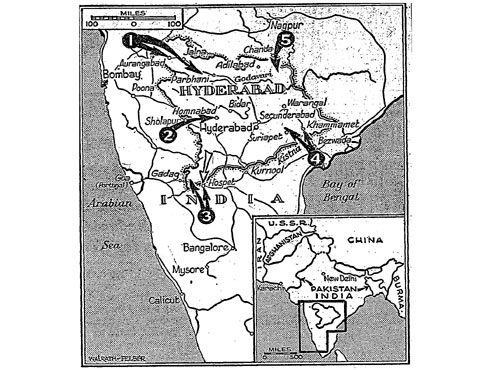It's a bloody war against Hyd Nizam

By D SIVA RAMI REDDY
pages from newyork times
The demand for declaring September 17 ‘Liberation Day’ has been making the rounds since the merger of Hyderabad State with the Indian union. From the historic perspective – in which Hyderabad state was reeling under the oppressive onslaught by the Razakaars and unhindered feudalism sponsored by the Nizam - the liberation should have occupied a position of sanctity. The accession of Hyderabad came as a salvation from the oppression and repression and the Nizam’s designs to either make the State independent or reportedly merge it with Pakistan. However, the demands for declaring ‘Hyderabad Liberation Day’ have since Independence been systematically stymied by political connotations and vote bank priorities. Metro India delves into retrospect to bring out the events that led to the merger of Hyderabad with Indian Union.
September 17, 1948 is a red letter day in the annals of Hyderabad. The princely State of Hyderabad gave up its resistance and announced through a radio communiqué from Pakistan that it is joining India. Though it may look like a plain vanilla statement, a week before September 17 was indeed bloody in the province of the Nizam’s Hyderabad State. A blow by blow account was reported in the New York Times edition dated September 16, 1948. Here are the excerpts:
Indian troops captured Aurangabad, a city of nearly one million inhabitants and second largest in Hyderabad, without resistance this morning after troops of the Princely State had evacuated the historic former capital of the Moghul Emperors, an India communiqué announced. Elsewhere, however, the Indians were meeting fierce opposition in the first major internal conflict in India proper- barring religious outbreaks –since the Sepoy Mutiny against the British in 1857. The Indian Military spokesman acknowledged that the core of resistance was yet to be met as Indian armored units pushed ahead along the main roads from five directions towards Secunderabad and Hyderabad city, the State’s capital.
(The Hyderabad case is to come before the United Nations Security Council in Paris Thursday at 3 P.M.)
In communiqués and radio broadcasts, both sides asserted that they had the support of the State’s population, who are seven eights Hindu, although the Nizam (ruler) and the overwhelming majority of the ruling class are Moslems, opposed to joining the predominantly Hindu dominion of India. There have been no reports of communal violence since the invasion began at dawn Monday, but no neutral observers or even Indian press correspondents have been allowed to accompany the troops and the Government is enforcing a strict blackout of news that might set religious rivalries aflame.
Chakravarthi Rajagopalachari, the Governor General, who on Monday had proclaimed a state of ‘grave emergency’, promulgated today a ‘public safety ordinance” giving wartime powers to the central and provincial Governments. This evening Delhi National Call reported the arrest of more than 330 persons, of whom all but half a dozen were Moslems, as a security measure in various towns near the Indo-Hyderabad border.
Occupy Northwest Corner…
Indians now occupy the entire northwestern corner of the 84,000 square-mile State and a narrow strip almost the length of the northern border. They also hold a deep rectangular pocket on the western side, extending about half way to Secunderabad from the border near Sholapur. Other pockets are being extended from the southwestern tip between Hospet and Gadag and southeast from the border near Bezwada to Suriapet.
Suryapet, an important road junction village eighty miles southeast of Secunderabad and nearby Khammammet have been taken against strong resistance by Hyderabad troops and Razakars (armed Moslem volunteers), the Indian communique said.
The Indian troops pressed forward three miles from Suriapet, defence headquarters have announced, according to the Associated Press.
The Indians said they had made further advances along the Sholarpur-Secunderabad road, where State forces and Razakars fought bitterly from dug-in positions on either side of the highway. Homnabad was captured in this sector, while troops advancing from Jalna in the northwest were said to have seized an important bridge at Shagadh.
(From Jalna the Indian troops advanced forty miles and entered Parbhani district, presumably heading for the Parbhani, seventy miles to the Southeast, the Associated Press reported).
Tonight’s communiqué from Hyderabad side, heard from the Pakistani Radio, declared that Hingoli, 115 miles east of Aurangabad in the north, and three other towns in the western sector were retaken by the State troops. The Hyderabad radio said that the Indian advance had been checked and that the invaders were bringing up reinforcements.
Indian air attacks continue
Indian air attacks continued for two days on airfields. Hyderabad has six air fields, at Aurangabad, Adallabad, Hakimpet, Warangal, Aler and Bidar. The field at Hakimpet, which serves Hyderabad city, had been operated by the Indian Government under the standstill agreement by the Royal Indian Air Force. India’s communiqué said counter attacks by Hyderabad troops still continues between the Ginigera and Hospet positions, but ‘it is being gradually overcome’ , the communiqué said.
Upon the fall of Homnabad, ninety-three miles west of Secunderabad, Indian commanders reported the capture of a large quantity of modern arms, including mortars, machine guns and light automatic weapons,hand grenades, and armored cars. The Razakars are said to be armed with 303 rifles.
-
Related News
-
More from Metro India

